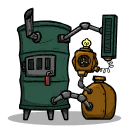Base Properties
Thermal Conductivity:
0.0146
Heat Capacity:
0.846
Hardness:
0
KG/tile:
1.8
Light Absorption:
10.0%
Transitions
Consumed continuously
Consumed on use
Infinte sources
Produced continuously
Atmosphere for
Member of group
Description
Explanation
- Thermal conductivity is how quickly heat moves through the element as a medium. You would want low conductivity when insulating your base, but high conductivity when transferring heat to be deleted.
- Heat capacity is how much energy is required to raise the temperature of the element by 1 degree. Some elements like water need lots of energy to be heated, others like metals, need much less.
- High temp & Low temp relate to when the material will transition into another material/state. Note that in order to actually transition up the temperature must be 2 degrees higher than the figure shown. E.g. Water becomes steam at 99.35+2 C. Similarly to transition down, the temperature must be 2 degrees below the transition temp. This prevents elements from jumping constantly between states.
If you like using Oni Assistant and want to give back, the best way is to link it on your forums and socials.
K




















































